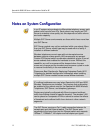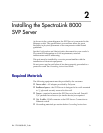
SpectraLink 8000 SVP Server: Administration Guide for SIP
PN: 1725-36033-001_C.doc
10
Multiple SVP Server Capacities
The system capacity of each SVP Server model is shown in the tables
below. Note that SVP Server models may not be combined within one
subnet.
SpectraLink SVP010 and SVP020 Server capacity
The system capacity of the SVP010 and SVP020 is measured by
number of powered-on handsets. If this number exceeds the
maximum, the handset that cannot be served will display an error
and will not connect to the SVP Server. Other handsets will not be
affected.
Number of handsets Number of SVP
Servers
SVP010 SVP020
1 10 20
2 20 40
3 30 N/A
4 40 N/A
SpectraLink SVP100 Server capacity
The capacity of the SVP100 Server is determined by active calls. The
table below shows the capacity of an IP gateway in a multiple-SVP
Server environment. The table shows the total possible calls at 100%
active calls. However, since it is unlikely that all handsets will be in
use at the same time, the table then analyzes the number of handsets
that could be installed in any given system where 10%, 15% or 20% of
the handsets are in active calls at any one time. The calculations are
not linear due to the Erlang
1
calculation for telephony traffic. The
1
An Erlang is a unit of telecommunications traffic measurement. Strictly speaking, an Erlang represents the continuous use of one
voice path. In practice, it is used to describe the total traffic volume of one hour.
Erlang traffic measurements are made in order to help telecommunications network designers understand traffic patterns within
their voice networks. This is essential if they are to successfully design their network topology and establish the necessary trunk
group sizes.
Erlang traffic measurements or estimates can be used to work out how many lines are required between a telephone system and a
central office (PSTN exchange lines), or between multiple network locations.
Please visit www.erlang.com
for additional information.


















